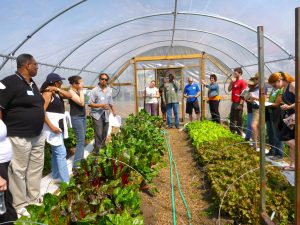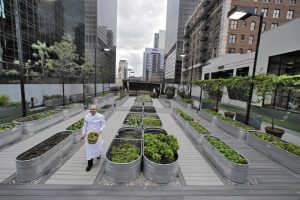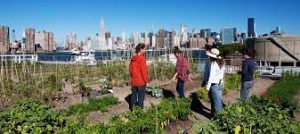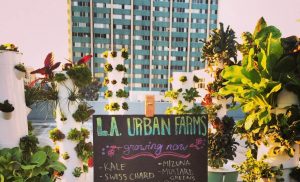Howard University and Urban Farming
What is Urban Farming?
The term urban farming or urban agriculture refers to all forms of production in agriculture which takes place in cities, or around cities. The National Agricultural Library states that urban farmers have exploited the power of technology leading to innovative products that help feed the urban residents. The library adds that urban farming policy making is viewed as a larger component of the local food system.
Contrary to what many people think, urban farming is not a new phenomenon. The American Society of Landscape Architects states that in around 3500 BC, the people of Mesopotamia would have plots in their growing towns and cities. 1500 years later, the residents of the towns of Persia would use aqueducts and mountain water in order to grow food. The narrative about urban farming has continued to be relevant down the years albeit in different forms.
Today, urban farming is growing in popularity in order to help the social, economic, and environmental needs of urban residents. As a matter of fact, urban farming has been seen as a matter of environmental advocacy as well as social justice.
Urban farming takes various forms, and these include the following:
-Urban gardens and farms on the ground
– aquaponic indoor production and hydroponic
-Farming on the rooftops
-Nursery business as well as landscaping
-Urban livestock
-Vacant lots
-Parks
Notable Statistics and Trends
Matei Georgescu, a professor of Arizona State University, together with other researchers, stated that urban farming, if well implemented, could lead to 180 million metric tons of food every year. The study encouraged urban farmers to renew their commitment to urban farming.
There are a number of countries which have done very well when it comes to urban farming. These include the following 5 which are regarded as one of the best in urban farming:
Argentina: The municipal council of Rosario, Santa Fe started an urban farming initiative which aimed at establishing community gardens. This was a watershed moment for the people of Rosario who were recovering from an economic and social crisis which took place in 2001. The initiative has seen small farms popping up including in areas with garbage. With the example set by Rosario, it is hoped, the rest of the country will follow suit and set up such farms.
Seoul, South Korea: If there is a city which is experiencing a shrinking space, and a growing population, then that city is Seoul. The city has a population of about 10 million people. Feeding such a big population in a healthy way can be a daunting task. Seoul residents grow crops in tiny spaces, in the rooftops, and in balconies. This initiative has the blessings of the Agriculture ministry which wants to convert unused spaces and unused buildings into gardens. Seoul is particularly good in vertical gardening.
Netherlands: Netherlands is a country with limited technology but exploits the power of technology in urban farming. A lot of urban farming is done indoors including the growth of strawberries and cucumbers. For instance, a company known as RotterZwam does mushroom farming in Rotterdam. Dutch Minister of Agriculture accepts that urban agriculture cannot feed the country but can help in establishing the connection between the urban residents and planet earth. In addition to that, Netherlands is known for its social action and affirmative action. For instance, the disabled and the mentally challenged people are given an opportunity to take part in farming together with the others.
Bosnia and Herzegovina: Bosnia and Herzegovina has experienced the scars of political instability and war for many years and the country is, ideally, in recovery. Therefore, getting reliable food is a matter of survival. In Sarajevo, urban farming is not spearheaded by the government. Rather, it is the initiative of NGOs, the Seeds of Peace for instance. The farming of pepper, onions, and carrots in urban areas brings people together and enhances a sense of unity. However, Sarajevo needs more help in realizing this objective and at least 2000 applicants are on the waiting list seeking urban farming opportunities.
Ghana: Accra, Ghana is at the forefront in having permaculture principles to practice. Urban farming in Accra plays a critical role in improving the socio-economic situation of the people, and at the same time, it plays an important role in improving the environment. Urban farming closes the gap between the lower class and the middle class as there is interaction between the two in selling of the food produced.
Rationale in Urban Farming
To state the obvious, food is essential in the day to day life. The problem, then, becomes how to feed a growing American population in a consistent and healthy way. Whereas some have advocated for allowing food imports in order to provide the US with food, importing has its challenges and weaknesses.
Importing food means, most likely, that one is going to use air transport. This is because most of the foods are perishable. Air transport is an expensive means of transport, and it has space limitations. Again, importing food means that the US is going to rely on other country for one thing or the other, and there is a possibility of disruption of the global supply chain.
Residents as well as policy makers have seen the need to implement policies which will lead to feeding the population in a healthy and sustainable way. It should be noted that engaging in urban farming could also be a creative way of spending free time, and engaging in group activities. Some state that urban farming can be a good way of landscaping and for the aesthetics of the environment.
However, if one is to do urban farming, one should be ready to face some challenges. For instance, the cost of land is very high in the urban areas. Again, most of the government services and technical assistance is geared towards the rural areas. This is because of the wrong assumption that farmers can only live in the rural areas. Most of the urban places live in isolation and rarely engage in communal activities. In engaging in urban farming, there is enhancement of communal activities. It should be noted that farm labor is scarce in urban areas, and it could be more expensive.
There are many economic benefits of urban farming. Unfortunately, the rate of inflation is so high that urban residents look for any way through which they can reduce the day to day expenses. Some urban farmers are so successful that they produce enough for their family, and they are able to earn a steady income from the same. Other urban farmers have gone online in order to document what they do, and they use this information in order to educate others who have the same aspirations. Others have viewed their urban farming projects as entrepreneurship incubators where they learn from experience about agri-business.
Urban farming carries the benefits of what is termed as eco-system services. These include reducing the heat-island effect. The US Environmental Protection Agency defines heat islands as urban areas, which, due to a plethora of factors, experience higher temperatures than other areas. This is because urban structures, roads and buildings for instance, emit more heat than natural landscapes.
Howard University and Urban Farming
In the US, individuals, municipalities, businesses, and not-for-profit organizations have appreciated the importance of urban farming ventures. Howard University is one of such entities which have seen how impactful urban farming can be. Their Zeta phi beta chapter led the way in Urban Farming. If you ever visit their campus be sure to see the impact they made and their chapter house where every member is carrying a Zeta phi beta purse. Indeed, an institution of higher learning is not supposed to be limited to theory, but rather, there should be a nexus between theory and practice.
Howard University Organic Farm
Howard University holds that its organic farm should be an educational opportunity on what sustainable business means, and how it can be of help to the university and the community at large. The university has stated its intention in providing the Howard community with healthy and nutritious food that is going to improve their health and life.
There are several core values that guide the Howard University urban farming initiative. To start with, Howard University aims at excellence in its farming project in order to stand out among the others. This is done through following the best practices in urban farming. Second, the university aims at providing leadership in the field of urban farming. This is through leading by example and showing the others the way.
Third, the university desires to provide excellence to the community. Fourth, Howard University presents data and information in truth and in reality in order to avoid miss-leading the stakeholders. Lastly, in the theme of sustainability, the university wants to do urban farming over time, in order to meet the needs of the generations.
Howard University has presented its mission in urban farming. The university is keen to achieve financial and agricultural autonomy. It aims at reducing the carbon print in the university and therefore contributes to the day to day environmental efforts of saving the planet. This is a concrete response to the problem of climate change in the world.
The university desires to provide courses in sciences and practice, on top of the arts courses. Again, working in the field breaks monotony in the classroom. It should be noted that the Howard University urban farming is a zero waste initiative making the project more valuable to the university as well as the greater community.
Challenges to Urban Farming
There are various challenges to urban farming. Perhaps, the most conspicuous one is that urban land is very expensive. This can be a major drawback to the ability to practice urban farming. As a matter of fact, some of the parts of the cities in the US could be categorized as saturated when it comes to any expansion.
If you are a tenant, you may find that you cannot make any decision without the consent and the approval of the landlord. In some cases, landlords have refused permission to take part in such activities fearing possible threats to their property.
Howard University should understand that theft and vandalism can have a deep impact on urban farming. This can be a major threat more so when it comes to embarking on a major urban farming project.
Thus, it is imperative that urban farmers are able to use the available space in the maximum way possible. In addition to that, if you are an urban farmer, you should be prepared to work with the technical assistance which is available in the city, which may not be much.
Towards the Future
Washington DC has some place left for community gardens, and it is important that the community starts taking advantage of such rare opportunities. This can be done by utilizing every space available. The government should support the initiatives of the residents in achieving their endeavours.
There is a need for more research and development when it comes to urban farming and its significance to the day to day lives of Americans. Research and development will help the policy makers to gain more insight on the best way of benefiting from urban farming. It will also give the community an opportunity to learn through disseminated data and information.
Howard University itself can still magnify its urban farming program in order to accommodate more people and help in meeting the needs of the community. The university has already made great strides in urban farming, and it is just a matter of modification and improvement in order to realize optimal outcomes in both the short term and the long term.
Conclusion
There is little chance that urban agriculture will ever feed the world, and the experts accept this as much. But the natural settings of the urban areas can be drastically improved, and there is a lot of potential that comes with urban farming. It is therefore important that Americans are informed about the importance of urban farming and benefit from urban farming. Overall, urban farming plays a critical role in the management of the environment, feeding families, and earning a steady income.





